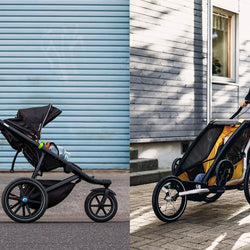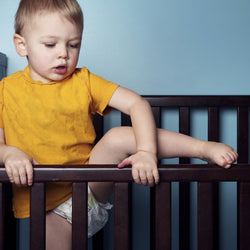12 Baby Teeth Myths Exposed

by Annie Wiesman
Sep 18, 2018
So many things are running through the sleep-deprived mind of a new mama. How often should I be feeding my baby? Is she getting enough to eat? How do I sleep train? Am I ever going to sleep again?
A few months pass and you start to wonder why is my sweet, snuggly baby crankier than usual, drooling more, and not sleeping as well? Am I right to suspect that teething may be the culprit?
There is a lot of information about all things related to teething and a plethora of advice swirling out there. I want to set the record straight and give you everything you need to know about baby teeth.
Myth #1: Baby teeth come in at six months
Fact: Teeth can erupt (come in) as early as three months and as late as fourteen months.
Fun fact: A child’s twenty primary teeth begin to develop between the sixth and eighth week of prenatal development and are present in the jaw at birth. All twenty teeth will erupt by the time they are three years old. The chart below indicates the approximate times teeth will erupt and shed (fall out).

Myth #2: It will be obvious when my baby is teething.
Fact: All kids are different and they may or may not display signs of teething. I didn’t seem to notice much of a difference in my teething baby. There are, however, a few common signs to look for when baby is teething. (But you may only make the connection that a shiny new tooth was the cause in retrospect.) Babywise writer Linda Scruggs notes the most frequent teething indicators:
• Refusing or fussy feedings
• Increased irritability and crying
• Increased drooling
• Changes in bowel movements
• Sleep disruptions
Article Continues Below Advertisement
Myth #3: Runny noses and low grade fevers are signs of teething.
Fact: While the body temperature may increase slightly when teething, it’s not enough to be considered a fever according to research analysis of several studies done by the AAP. Any signs of illness such as runny nose and fever should be treated as such and not automatically attributed to teething.
Myth #4: There’s nothing I can do to help with teething discomfort.
Fact: Linda offers a few tips for soothing a teething baby:
• Rub the gum gently using a clean finger for 1-2 minutes.
• Provide safe teething tools.
• Offer baby a cold washcloth.
• Check with your pediatrician if you are considering over-the-counter infant pain relievers.
Teething discomfort should only last for a few days. Pay attention to baby and your intuition. Provide lots of extra snuggles and don’t be afraid to call your pediatrician about anything that just doesn’t feel right.
Myth #5: Baby teeth will fall out sooner or later so they are not as important as adult teeth.
Fact: Baby teeth are quite important for baby’s development and health. In addition to helping baby chew, speak, and smile, baby teeth also hold space in the jaws for permanent teeth that are growing under the gums. If a tooth falls out too soon due to decay, it could cause problems for placement of future teeth.
Myth #6: Baby teeth do not need to be brushed too often.
Fact: Part of the Babywise philosophy is “begin as you mean to go on” and this applies to teeth care as well. We all know that brushing our teeth twice a day is part of the necessary dental health, so the same is true for baby teeth.
• You can begin to care for baby’s mouth right away by gently wiping gums once a day with a clean, damp washcloth.
• Once teeth start to come in, you can begin brushing teeth with a fingertip toothbrush or small, soft bristled brush. Children under three ought to have their teeth brushed twice a day with just a smear of toothpaste on the toothbrush.
• Children 3-6 may use a pea size amount of toothpaste, brushing twice a day. Children should be supervised to ensure proper technique and be reminded not to swallow the toothpaste.
Article Continues Below Advertisement
Myth #7: My child doesn’t need to use fluoride toothpaste until he is older.
Fact: Because tooth decay is possible as soon as teeth are present, the American Dental Association (ADA) recommends use of fluoride to enhance cavity prevention. Small children tend to swallow the toothpaste, so a smear of toothpaste is enough. As children are able to spit while brushing, a pea size dot is adequate. Oftentimes fluoride is present in our drinking water, but check with your dentist to see if they recommend fluoride supplements or a topical fluoride solution.
Myth #8: I don’t need to floss my child’s teeth.
Fact: When teeth are touching it is important to assist in the removal of food by gently flossing in-between teeth. A small dental floss pick makes it easier to get inside a little one’s mouth.
Myth #9 A child doesn’t need to visit a dentist until he is three years old.
Fact: The ADA recommends that the first visit should be no later than the first birthday. Check with your pediatrician and your own dentist to see when they start seeing patients. My pediatrician said I could wait until three years old and my dentist said wait until she would tolerate it. I took my four year-old for the first time and she did great and had no issues.
Myth #10: Pacifiers and thumb sucking are bad for teeth.
Fact: Both pacifiers and thumb sucking are strategies children use to self-soothe as they are falling asleep and both are habits that are breakable down the road. The use of pacifiers has even been thought to help prevent SIDS. Overuse of both could be bad for a child’s teeth, but if used only at bedtime it should not pose a long term problem. The American Academy of Pediatric Dentistry recommends that children be weaned from a pacifier by age two and from thumb sucking by age three to prevent changes in tooth placement and jaw alignment.
Article Continues Below Advertisement
Myth #11: All baby teeth fall out.
Fact: All teeth may not shed on their own; some may need to be pulled to make room for adult teeth that still need to come in. Typically, at around six years of age, the first teeth in are the first to be pushed out by the adult teeth. Whether they are shed naturally or need to be pulled out, all 20 baby teeth will need to come out eventually to make room for the 32 adult teeth.
Myth #12: All tooth holding products are cute.
Fact: Treasure chests and tooth holder necklaces are beloved ways to bring home a lost tooth from school, but the Baby Tooth Album is decidedly not cute; it is, in fact, creepy. They try so hard to make it sweet and sentimental when they call it a “beautiful keepsake box to cherish for a lifetime.” But then you stop and think about the fact that you are saving and displaying dead teeth! Kind of gross people!
Don’t let teething and dental care be something you are uncertain and fearful of: arm yourself with knowledge and move forward in confidence as you care for the sweet gift that has been entrusted to you and . Eagerly anticipate those teeth milestones, but don’t be tempted to preserve your child’s teeth forever in a “beautiful keepsake box.”
Annie Wiesman
Annie Wiesman is the co-author of “Education Begins at Birth: A Parent’s Guide to Preparing Infants, Toddlers, and Preschoolers for Kindergarten.” She is a former kindergarten teacher turned stay-at-home mom who enjoys traveling, hiking in the mountains, and creating memories together with her husband and little girl.










